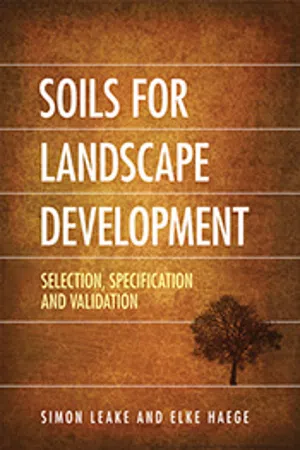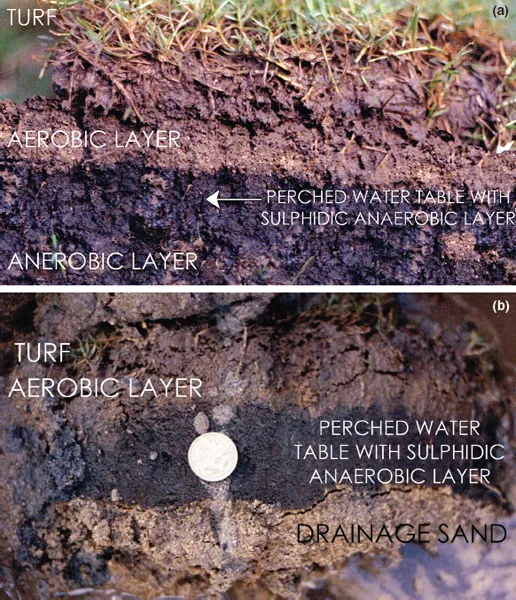
eBook - ePub
Soils for Landscape Development
Selection, Specification and Validation
This is a test
- 192 pages
- English
- ePUB (mobile friendly)
- Available on iOS & Android
eBook - ePub
Book details
Book preview
Table of contents
Citations
About This Book
Soils for Landscape Development provides a clear, practical and systematic template for specifying landscape soils based on scientific criteria. The soil specifications provide essential information and a universally applicable method for landscape architects and designers, specification writers, landscape contractors and soil supply companies to ensure quality and fit-for-purpose soils. A strong emphasis is placed on reducing environmental impacts by reuse of on-site soil, promoting appropriate minimal soil intervention, and using recycled products.
Frequently asked questions
At the moment all of our mobile-responsive ePub books are available to download via the app. Most of our PDFs are also available to download and we're working on making the final remaining ones downloadable now. Learn more here.
Both plans give you full access to the library and all of Perlego’s features. The only differences are the price and subscription period: With the annual plan you’ll save around 30% compared to 12 months on the monthly plan.
We are an online textbook subscription service, where you can get access to an entire online library for less than the price of a single book per month. With over 1 million books across 1000+ topics, we’ve got you covered! Learn more here.
Look out for the read-aloud symbol on your next book to see if you can listen to it. The read-aloud tool reads text aloud for you, highlighting the text as it is being read. You can pause it, speed it up and slow it down. Learn more here.
Yes, you can access Soils for Landscape Development by Simon Leake,Elke Haege in PDF and/or ePUB format, as well as other popular books in Architecture & Urban Planning & Landscaping. We have over one million books available in our catalogue for you to explore.
Information
Topic
ArchitectureSubtopic
Urban Planning & Landscaping1
Introduction
1.1 Why are these soil specifications needed?
A definition of landscape soil
Landscape soil is an anthropic soil profile that is either modified from a natural in situ soil or manufactured and installed using artificial components for the purpose of sustaining vegetation chosen for landscape design or land rehabilitation.
Many good landscape design ideas fail, or do not perform well in practice, because of the use of inappropriate or unsuitable soil or growing media. The use of unsuitable landscape soils occurs because of a three-fold breakdown in the contract system:
1.A lack of understanding by designers and contract specifiers on how soils should be specified. Here is a typical example of the flawed ‘recipe-based’ approach that is the most common method used by landscape architects:
•1 part Kenthurst Black Loam or any other location-based mined material that is not clearly defined.
•1 part sand.
•1 part aged mushroom compost.
There are many errors inherent in this specification that could lead to failure of the landscape.
First, it was made at a time when ‘Kenthurst Black Loam’ was no longer available, meaning the specification is impossible to supply and would immediately require a variation.
Second, there is no indication of what pH or any other soil property is required. Mushroom compost is highly alkaline because it contains excess lime, therefore any plant intolerant of lime (most plants) would suffer chronic ‘yellows’ (iron deficiency chlorosis). Also, mushroom compost is often extremely high in phosphorus so phosphorus-sensitive plants (many, though not all, Australian natives) would die or suffer chronic phosphorus toxicity. The landscape in this case study specified many Grevillea and Banksia plants that are known to be highly phosphorus sensitive.
Finally, the specification makes no mention of physical properties, and the use of a fine sand combined with a structure-less loam is likely to provide severe drainage problems (see Failed project example 1 below).
2.Few commercial soil suppliers conduct any (or adequate) research or trials on their products. In litigation cases, the court will deem that a soil supplier is expert in soils. Therefore, if a soil supplier supplied the above soil mix knowing there were many P-sensitive native plants to be planted in it, or if asked to supply a soil suitable for native plants, a court could make a finding against them because they should reasonably have known that ‘mushroom compost’ is highly likely to be toxic to these plants. Some commercial soil suppliers have staff with adequate qualifications and experience, but there are many smaller soil suppliers that do not (see Failed project example 2 below).
3.The third and final flaw is the temptation by landscape contractors to source a very low cost, inferior product. This often occurs because checking, testing and quality assurance checks are seldom required and, when they are, often contractors resent the cost imposition (because it is currently not the industry norm). As well, even where landscape contractors’ intentions are honest, levels of training and experience vary widely and it is surprising how many would not know that mushroom compost is toxic to many common landscape plants (see Project examples 2 and 3 below).
1.2 Lessons from failed project examples to demonstrate why we need this handbook
Failed project example 1
Part of the project that employed the soil ‘recipe-based’ specification above called for its use on a rooftop turf installation. The idea was for a nice open area of lawn for workers to have lunch and relax during breaks. The specification called for a waterproof membrane over the concrete, a drainage ‘cell’ over that to conduct water away, a geotextile fabric over that then, very importantly, a layer of sand to prevent blockage of the geotextile with silt, then the soil layer and then turf. All this is good and ‘to the textbook’. The problem was that the soil was too fine and created a ‘perched’ watertable because of the texture difference between the fine soil and the coarse sand. The black layer in the photos in Figure 1.1 represents the totally waterlogged ‘capillary fringe’ where the sulphate from the mushroom compost (also typically high in gypsum or calcium sulphate) had been reduced to black sulphide with the accompanying smell of rotten egg gas and resultant failure of the landscape.
Failed project example 2
In a major redevelopment project, the landscape architecture firm went to the extent of including a performance-based specification similar to those advocated here for, among other things, the installation of a rare and endangered native (Australian) plant community. Critical was the very low phosphorus level required by the specification. The contractor brought in the soil–compost mix recommended for natives by their local supplier. The supplier had clearly not allowed for the provision of analysis and, when asked to provide one before installation, the supplier provided the following information:
‘Compost mix of equal parts mushroom, chicken and duck manure’:
•Compost analysis: 12 000 mg/kg of ‘available’ phosphorus.
•1 part in 5 with site soil.
The compost was composed of equal parts mushroom compost, chicken manure and duck litter. Note the mix shows 12 000 mg/kg of ‘available’ phosphorus. The error, which would have been fatal to many of the specified plant list species, was picked up, not by the landscape contractor or the soil supplier, but only by the last minute insistence on adherence to the specification by the landscape architect.

Figure 1.1. Images of perched watertables.
Failed project example 3
A local council had the laudable idea of showcasing some of its original native floral types in a waterfront park. There are no records of any soil specification for the project. After multiple plant losses and deaths and three re-plantings over 4 years some soil tests were finally commissioned. The problem shown in Figure 1.2 is severe manganese deficiency induced by very high pH and phosphorus levels. It was diagnosed by foliage analysis that showed only 1 mg/kg of Mn in the foliage. The soil was very high in lime, phosphorus and organic matter, all of which conspire to reduce Mn uptake. It was totally unsuitable for the purpose of growing native vegetation. The problem could not be rectified and all the soil had to be replaced. The council gave up and reverted to lime-tolerant plants only. A soil investigation and technical performance specification as advocated in this book, would have saved tens of thousands of dollars in public money.

Figure 1.2. Severe lime-induced manganese deficiency in Pomaderris ferruginea (Source: Simon Leake).
1.3 The function of this handbook
Currently, the industry in Australia relies upon a combination of an in-house ‘recipe-based’ specification, Australian Standard AS 4419 and NATSPEC to develop specifications for construction tenders. These approaches are too broad and non-specific to provide any precision to the many design situations faced by normal landscape architecture practice and can result in the supply of soils that are not fit for purpose. Soil companies vary in their level of quality and fitness for purpose, seldom test every batch and are also influenced by the economics of materials supply.
None of these approaches are ‘performance- or technical product-based’ specifications in the way that, for example, the concrete industry uses to ensure the product is always fit for purpose. Some soil suppliers provide what might be called performance specifications in the form of product information sheets but these vary in both the detail and accuracy of the representations made on such information sheets.
This industry-wide problem occurs in many commercial suppliers both in Australia and overseas and has been acknowledged in overseas-based reference books and at international workshops on the subject.
Soils for Landscape Development provides an objective, science-based approach to choosing and specifying soil media for landscape design, instead of providing vague ‘recipe-based’ specifications that often rely upon brand or proprietary products from manufacturers. It sets out key chemical and physical properties the soils must meet, as well as providing information about how this can be achieved. This approach is unique in the literature on landscape soil specification.
1.4 Who will use this handbook?
This handbook is written for landscape designers, landscape construction contractors and soil supply yards. The landscape designers will use it to better understand the soil resources they may have on a site or to better understand how to specify soils using the ‘copy and paste’ individual specifications. Landscape contractors will use it to ensure supply yards provide them with soils suitable for the project.
Soil supply yards will be in the position of having to ensure the soil they supply to a project meets the specifications. They will have to use soil testing to demonstrate this. Rather than doing last minute soil design and testing for individual projects – or worse, having to do expensive soil testing for a small supply contract – suppliers are strongly encouraged to make ‘off-the-shelf’ products that meet the specifications so they can quickly show up-to-date compliance certificates and hence avoid the cost and time impositions on each project. The quality control specifications (G1) provide the mechanism for certification via properly constructed ‘product representation sheets’ (i.e. pre-approved soils meeting the specifications). Also, there is room for validation of minor variations where local supplies mean the specifications cannot be met strictly or, in the case of minor variations, provided a professional expert is giving the opinion.
1.5 Key benefits
We hope that the information and guidance together with the ‘specification templates’ presented in this handbook will move the industry from the traditional ‘recipe-based approach’ to a more sound urban soil science practice. The method developed is universally applicable and it is anticipated to provide an international standard in supply and installation of landscape soils regardless of the raw material at hand in any locality, although the specifications may need to be adapted to local conditions and practices.
Landscape architects and designers will be provided with a valuable resource that they can directly apply to their specifications, which will, in turn, improve the quality of their project outcomes. It will also improve the industry standards and allow a more level and fair tendering process for landscape contractors and a more level platform for soil supply companies. It will also rationalise the number of products and product variations available.
This sound research and clear layout provides an easy-to-use, systematic compliance process that is internationally applicable and will contribute to ensuring landscape soil meets the specifications before installation.
1.6 Structure of this handbook
This handbook is structured in a step-wise manner according to how project development and planning approach the design process. These steps include:
1.setting the project objectives
2.directing and conducting site analysis and soil investigation
3.generating informed design concepts
4.providing detailed design with specifications
5.enabling sound construction supervision.
1.7 How to use this handbook to drive your project
Table 1.1 outlines the series of steps in a typical project process. In order to create the most suitable performance specification, it is important to follow this process.
Table 1.1. Steps in a typical project process
| Steps | Details |
| Determine the project objectives | e.g. budget, scope, aesthetics, function, maintenance and other requirements |
| Analyse and characterise the existing site soil | Include depths, type, structure and other properties |
| Determine the ‘soil approach method’ | Reuse site soil, stockpile, import topsoil/subsoil/subgrade or remediate? |
| Use the three steps above to inform the design | Soil type and properties may influence plant choice and design |
| Document the stockpiling and stripping | Construction certificate and tender phase |
| Specify the profile depths and number of horizons for reconstructed soils | Such as an A/C or A/B/C profile (refer to Sections 4.3 and 4.4 on creating soil profiles) |
| Choose the individual soil specifications required | Include in the specification the various soil types required for the site |
| Validate the product specifications | Outline in the specification the appropriate method and detail required for product certification and ordering, signing off on landscape soil testing and approvals of site soil works installation |
1.8 Traps for unwary players (the most common landscape soil problems)
Failure of landscape installations is not just disappoi...
Table of contents
- Cover
- Title Page
- Copyright
- Contents
- Foreword
- Preface
- Acknowledgements
- 1 Introduction
- 2 Design development process and the soil approach
- 3 Understanding soils for landscape development
- 4 Soil design
- 5 Guidance to using the soil performance specifications
- 6 The performance specifications
- Bibliography
- Appendix A: Technical information, sampling and test methods
- Appendix B: Forms and templates
- Appendix C: Soil rooting volumes
- Glossary of industry terms
- Index